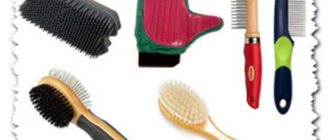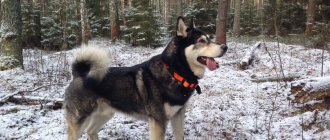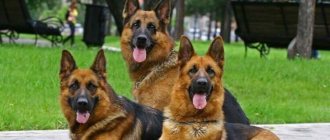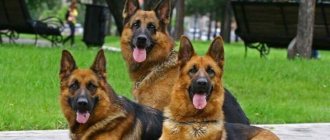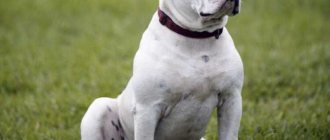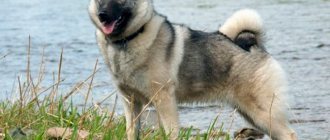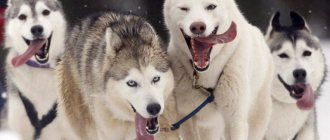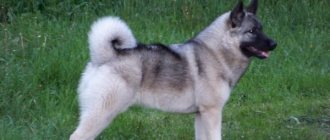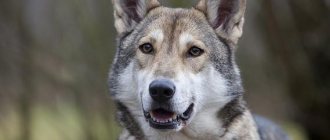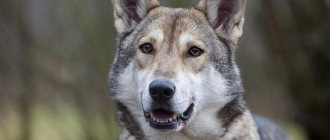From the history of the breed
Despite its centuries-old history, the Norwegian Elkhound breed was officially registered in 1901. From that moment on, mass breeding of these animals began. Long before the beginning of the twentieth century, the elk husky (as the Elkhound was previously called) was the national dog of Norway. She had an excellent scent, intuition, and individual tactics for pursuing the beast. These dogs were successfully used to hunt moose. The animals' fearlessness, endurance, and hunting passion allowed them to hunt bears. Today they are ideal assistants in hunting wolves, lynx and small game.
Laika from Norway and its history
If we could ask the Vikings or the people who lived in tribes in caves, they would tell us that even then the ancestors of the Norwegian Elkhounds were nearby.
The skeleton of such a dog was found by researchers in the Vist Cave in Norway. During excavations of Viking burials dating back to the 8th century, the remains of huskies were also found. The Laika from the North Country was nicknamed the Elk Dog due to the fact that elk were the breed's hunting specialty. Later, cattle breeders and shepherds also began to use Elkhounds as guard and guard animals.
In 1877, Norwegian hunters introduced dog handlers to huskies, whose exterior had been formed in natural conditions over centuries.
The Swedes and Norwegians were the first to recognize the breed, and after them the Elkhounds received recognition in other cynological associations. Today, in addition to the homeland of huskies, their breeding purity is maintained in the USA, Canada and Great Britain.
Wool
The Norwegian Elkhound has a luxurious coat, typical of northern dogs - gray, coarse hair with a light silvery soft undercoat. Such a cover is not afraid of any bad weather. There is a lush woolen collar on the animal’s neck. On the face, tip of the tail and ears the coat color is almost black.
The color of this breed resembles the coat of a wolf - gray wool with a light gray undercoat. The animal's fur requires special attention during shedding, which occurs seasonally; it is very active. The Norwegian Elkhound requires weekly brushing and combing with a special brush, which helps to minimize free hair loss.
Since this dog cleans itself naturally, it should only be bathed when absolutely necessary.
Characteristics and description of the breed
Height of males at withers: up to 52 cm
Height of the bitch at the withers: up to 49 cm
Weight: 20-25 kg
Color: shades of gray, but the tips of the hairs are always black, which creates an “irridescent” effect on the coat. The undercoat is light gray. There is a black mask on the face, and the fur on the ears is also black. A dark smooth line directed from the eyes to the ears is welcome. The presence of white spots is highly undesirable.
Breed standards:
- Body with a short and strong straight back.
- The ribs are voluminous, strongly curved, giving the impression of a “barrel”.
- The head is wedge-shaped with a wide muzzle at the base.
- Neat ears stand high, mobile, pointed, giving the dog a wary and attentive appearance.
- The nose is black.
- The eyes are medium size, oval, dark brown.
- The tail is curled in a tight ring, thrown over the back, with thick hair.
- The dog's body is covered with dense, thick hair with a soft undercoat; it creates a beautiful collar on the neck. At the same time, the hair on the paws and head is short.
Character
The Elkhound is an independent creature. Like other huskies, these dogs are independent and smart. But their most important quality is devotion to the owner. Elkhounds have another feature - they are extremely sensitive to affection and praise.
The Norwegian Elkhound is a friendly animal. The dog is cheerful and cheerful, but has self-esteem. From a very early age, the puppy needs a demanding, firm but affectionate approach. He gets along well with kids and adults, but is completely intolerant of cats and other pets. I would like to emphasize the Elkhound’s special attitude towards children. When playing with them, the dog shows such touching caution and accuracy that there can be no doubt that it cannot even inadvertently offend the child. This dog is a great friend for children. He is wary of strangers, but does not show aggression.
It is worth noting that the Norwegian Elkhound dog is extremely hardy and agile (reviews from the owners confirm this). She loves to run cross-country. The elk husky will happily go with its owner for a bike ride, a walk, or any outdoor activity. The Elkhound is a very smart dog. He instantly learns all the owner's commands.
A dog living in a family is very active and is very attached to its owner. You need to treat her kindly, but firmly. You should not spoil such a pet.
Behavior and temperament
Although the Elkhound is a typical northern dog that can work independently and survive in harsh climates, it is a gentle and sensitive , but at the same time vigilant friend.
Character advantages:
- friendly;
- quick-witted and intelligent;
- loyal, becomes attached to one owner;
- distrustful of strangers;
- affectionate with children;
- vigilant watchman.
There are also disadvantages:
- reacts too violently to suspicious noises, barks;
- independence and independent decision-making;
- dominates the owner;
- Without socialization, he is aggressive towards other animals.
Activity
The Norwegian Elkhound is not a breed that is suitable for living in an apartment. She needs physical activity and a large space, so it is best if the animal has a large fenced yard at its disposal. The dog will feel great on a farm, where he will have a lot of familiar work.
The Elkhound is a wonderful companion. Dogs of this breed have proven themselves well in protection, they are excellent watchmen, they herd livestock very skillfully, and when harnessed to a sleigh, they can transport loads.
Due to the thick, fleecy undercoat, the dog can hardly tolerate the heat, and on frosty winter days and even in inclement and rainy weather, it feels very comfortable. On summer days, the Elkhound loves to swim and hides from the sun's rays in a shady place.
Maintenance and care
In an apartment, a moose husky will not have enough movement and space to maneuver. It is worth getting a dog if you have a private house with a large yard where you can set up an enclosure. It is not recommended to keep your Elkhound on a chain.
Every week you need to brush your dog. You also need to keep your ears and eyes clean. It is rare to trim a husky's claws. Since dogs run around a lot, they wear out naturally. They bathe the dog once a year – in the summer.
Usage
In Norway it is used for moose hunting and as a companion dog. The Norwegian Elkhound has a unique tactic - having tracked and then driven the animal, it evades its attacks and, barking at the elk, holds it until the hunter arrives. In addition, these dogs are used to hunt large animals - wolves, lynx, bears.
An unusually developed sense of smell allows the dog to sense an animal at a distance of several kilometers. She uses a wide range of signals that are given by barking.
Elkhound is an excellent watchdog. In addition, these dogs have proven themselves well in agility; they are attentive and neat herding dogs.
In Europe, these dogs are often used in nursing homes, where they brighten up the leisure time of elderly and not very healthy people.
Pros and cons of the breed
Norwegian Hunters, like representatives of any other breed, have positive and negative sides that must be taken into account when buying a pet.
Among the advantages:
- expressive appearance;
- good health;
- devotion to the owner;
- developed working qualities;
- friendly attitude towards children;
- developed intelligence;
- ease of care.
The disadvantages of moose huskies include:
- stubbornness;
- heavy shedding;
- tendency to joint diseases;
- undesirability of living in an apartment;
- desire for dominance;
- excessive activity;
- the need for a long walk.
For those wishing to engage in breeding, an additional disadvantage is the low prevalence of dogs in the CIS. Finding a mating partner will not be easy.
Choosing a puppy
Norwegian Elkhound puppies are born completely black. Gradually their fur becomes lighter in color. Growing up, puppies change color several times.
They are playful and behave like wolves in a pack. By the time they go hunting for the first time, they resemble adorable plush wolf cubs.
We recommend purchasing such a four-legged friend only from an experienced and well-established breeder. The Norwegian Elkhound breed is not yet very common in our country. A nursery that breeds these animals cannot be found in every city. We can recommend you such institutions in Tambov, Orel, Moscow, Rostov-on-Don, Chita.
Elkhound puppy cost
Hunters value this breed for its high intelligence, quick reaction and excellent learning abilities. The price for a puppy with a pedigree starts from 700 euros and reaches 1500 euros. It all depends on who the dog's parents were.
It is possible to export Norwegian Elkhounds from the country only after obtaining special permission from RORS.
This breed is not very common in Russia and the CIS countries, but in recent years it has become more popular. Hunters learn about the working properties of the elk husky, and try to get a puppy in any way. It is worth knowing that only the puppy purchased from a Norwegian nursery will not disappoint the owner. Buying a puppy second-hand can be a huge disappointment.
Choosing a puppy
First, contact the breeder and ask when you can come to the nursery to meet the babies. When you arrive at the kennel, pay attention to the living conditions for adult dogs and puppies. In a good nursery, they are kept in a dry, ventilated room without drafts. There is no unpleasant odor in it.
Puppies should be active, not afraid of sharp sounds, and play with their brothers.
The breeder will present all the necessary documents, familiarize the buyer with the vaccination schedule and answer all his questions regarding the diet and maintenance of the dog. Today such a puppy can be purchased for 60,000 rubles.
How to choose a puppy
Buying a Norwegian elk husky in Russia is not easy, since the breed is not very popular and there are few nurseries. You may have to wait in line for a puppy. A purebred baby costs on average 500-700
Attention: purchasing a pet without documents based on an advertisement on the Internet may result in receiving a large, non-viable individual!
The breeder must present to the potential buyer the pedigrees of the baby's parents, the results of a complete veterinary examination of both the male and the female. With the puppy, the new owner is given a birth certificate (which can later be replaced with a pedigree), a veterinary passport with notes on the first vaccinations, and deworming procedures.
The dogs also need to be examined. If a pet is purchased abroad, this can be done via video call. Healthy puppies have the following characteristics:
- shiny coat without tangles or protruding tufts;
- the anus is clean;
- nose, ears, eyes without discharge;
- a lively, curious look;
- the tummy is well-fed, but not bloated (this is a sign of infestation);
- correct bite;
- straight limbs.
The small Elkhound has the following breed characteristics:
- short, proportional body;
- tail set high, curled over the back;
- gray-black color.
The puppies are active, curious, not afraid of new people, and do not aggression. They happily run out to meet each other and play with their brothers and sisters. You need to pay attention to the entire litter. If among the puppies there are clearly sick ones who are lagging behind in development, it is better to refuse the purchase. A number of dangerous infections may appear later.
Exterior and standards
The Norwegian Elk Husky is a compact, well-proportioned and robustly built dog with a format close to a square. Gender differences are manifested in gradations of height at the withers for males and females: 52 and 49 cm, respectively.
Manifestation of sexual differences in the exterior of the Norwegian Husky
The average weight of an adult dog is from 15 to 20 kg. The name “Norwegian Elkhound” combines two breed lines of elk huskies - gray (gra) and black (variety). The gray Norwegian Elkhound breed has been known for hundreds of years. Its modern variety, the black elkhound, is much younger: breeding work with it began only in the first decade of the 19th century. The main purpose of breeding both breeds is to hunt big game. Although these dogs are very similar in body type, the main difference is the color.
The Elkhound Gra's coat is colored in shades of gray, and the tips of the decorating hair are black.
Norwegian Gray Husky
Accordingly, the color of the Elkhound variety is characterized by black tones of varying intensity.
Norwegian black husky
The standards allow the presence of white markings in both varieties.
Small differences are also observed in the constitution: the gray husky has a body type close to the square type, while the black husky has a more flexible and lighter body. Despite the almost identical similarity of these two dogs, the FCI does not consider them within the same breed.
Table 1. Main differences in the exterior of gray and black Norwegian huskies.
| Parameter | Elkhound gra | Elkhound variety |
| Head | Wide in the back, with a short muzzle, tapering evenly from base to end. The transition from forehead to muzzle is well defined | Dry, light, tapering towards the end of the muzzle, with a straight profile and a relatively wide space between the ears. |
| Ears | Pointed, set high, with a height slightly exceeding the width at the base | Very mobile, set high, noticeably longer than wide at the base |
| Color of face and ears | Significantly darker than the main one | Same as main |
| Frame | Short, strong, somewhat barrel-shaped along the entire length, with a slight “undermining” | Short, with a well-developed, slightly barrel-shaped chest and muscular loin. The sacrum forms a straight line |
The remaining requirements of the standard are the same for representatives of both breeds.
- The eyes are brown, their cut is slightly slanted. The look is open and bold.
- The nose is black.
- The lips are dry, fitting well to the jaws.
- The jaws are deep, with a scissor bite and a full set of teeth.
- Flexible neck of moderate length.
Norwegian Husky - champion
- Both pairs of limbs have powerful bones and are strong.
- Compact paws are oval, gathered into a ball. Dewclaws are not allowed.
- The tail forms a tight ring and is pressed to the back.
- The coat has an abundance of guard hair, lush, medium length, thick texture. On the neck and shoulders - standing type and longer than on the rest of the body. The hair on the head is short and smooth in texture.
Gray Elkhound
For the gray Norwegian husky, the standard stipulates a lighter color than the main one on the chest, “shawl” (the transverse stripe behind the shoulder blades), belly, front parts of the limbs, feathers, and the underside of the tail. All other deviations from the gray color are not acceptable.
Nutritional Features
The Norwegian Laika is one of the most undemanding hunting dog breeds to keep. This is explained by the way of life of Elkhounds, which has been formed over centuries, which is characterized by constant restriction of food. But this does not mean that the dog’s diet should be meager and primitive: constant poor nutrition has a negative effect on the health, working qualities, and appearance of the animal. What type of food - natural or ready-made industrial - to give preference to is decided by the dog owner, based on his capabilities.
Natural and dry food
If dry food is chosen as the main diet, it should not be lower than the “premium” class. The best choice for regular nutrition are ready-made diets of the “super premium” and “holistic” classes, which comprehensively take into account the age characteristics and physiological status of the dog. They do not contain synthetic components; in addition to the necessary nutrients, balanced in qualitative and quantitative composition, their formula includes vitamin and mineral supplements.
The debate about whether it is worth feeding a dog with industrial food has not subsided for many years. One way or another, after assessing all the pros and cons, the choice is made only by the owner of the animal. You can find out more about how to accustom your dog to dry food in our separate article.
In addition to the class of food, its labeling is important : during periods of heavy workload or competition, it is advisable to purchase food for the Elkhound with the inscription “Energy” on the packaging.
Royal Canin Energy
Blitz
Experienced breeders believe that natural food is preferable for dogs of aboriginal working breeds. In this case, the basis of the daily diet of an adult animal is:
- proteins - 400 g;
- complex carbohydrates - 350 g;
- animal fat - 15 g;
- fiber - 150-200 g.
It should be taken into account that the content of components must be adjusted depending on the time of year:
Norwegian Husky in winter
- in winter, to compensate for increased energy costs, the proportion of protein is increased and the amount of fiber is reduced;
- in the summer, when appetite is reduced, more sources of fiber are added to the dog’s menu - vegetables, berries, fruits.
It is recommended to finely chop all products intended for feeding the Elkhound: in this way, the prepared food is digested faster and better, and the dog will be able to be active almost immediately after eating. The volume of a single serving in normal mode should not exceed 3% of the weight of the dog itself.
Dogs playing in the yard
This average amount of food increases by about 1/3 when going hunting. In order for the pet to develop normal eating behavior, they resort to regimented feeding: an adult Norwegian husky is usually fed 2 times a day. Regardless of the type of diet chosen, clean water should always be available to the dog.
